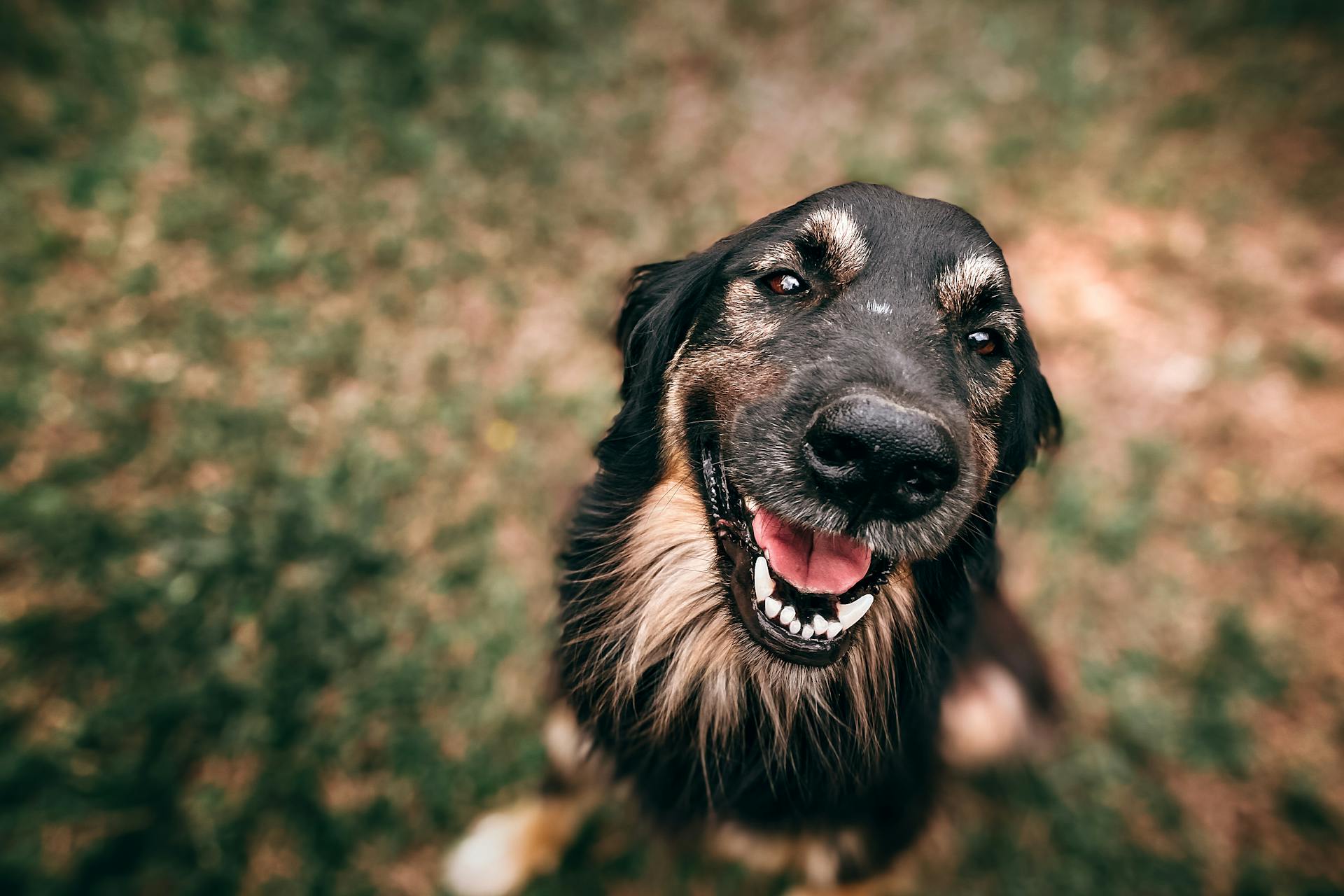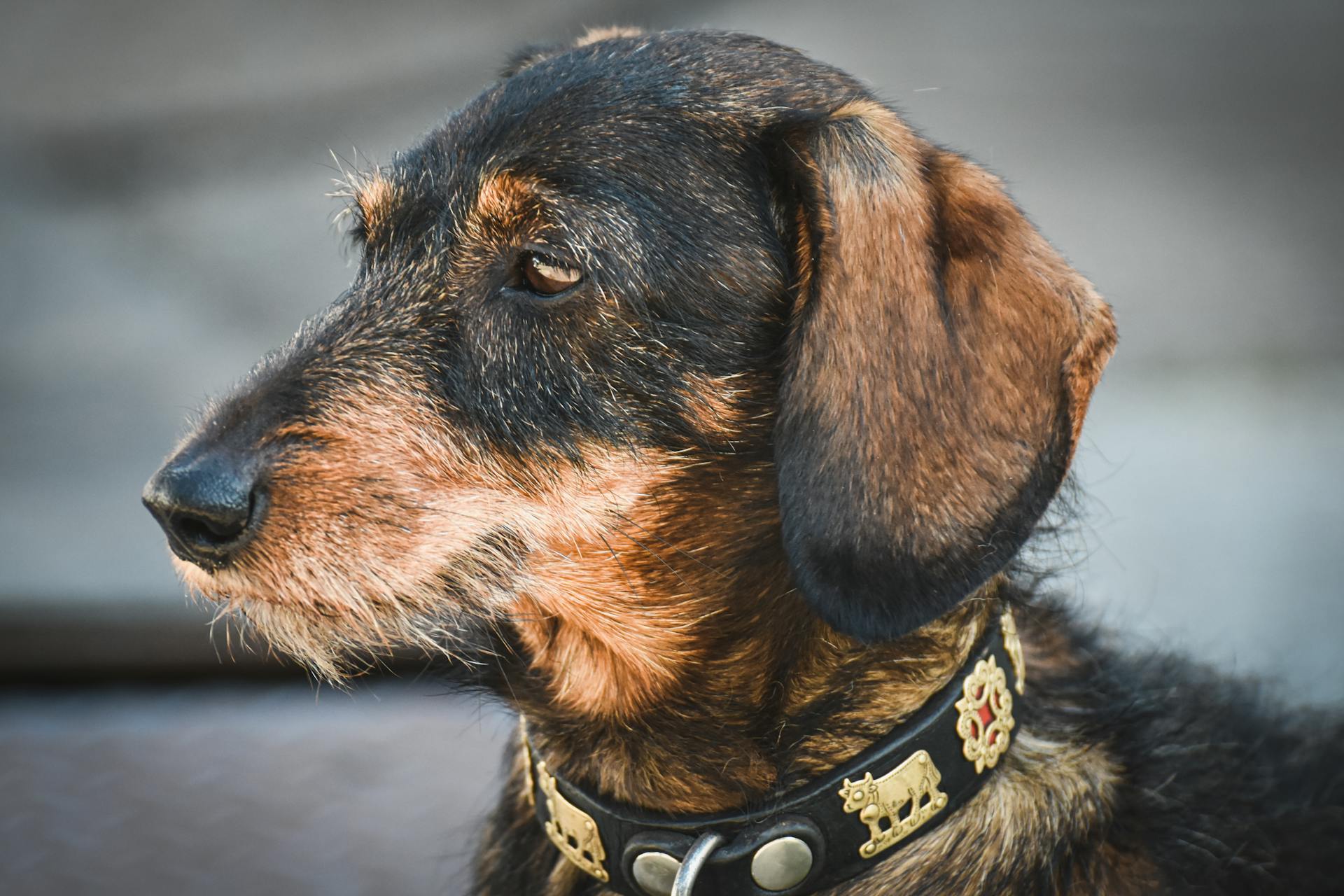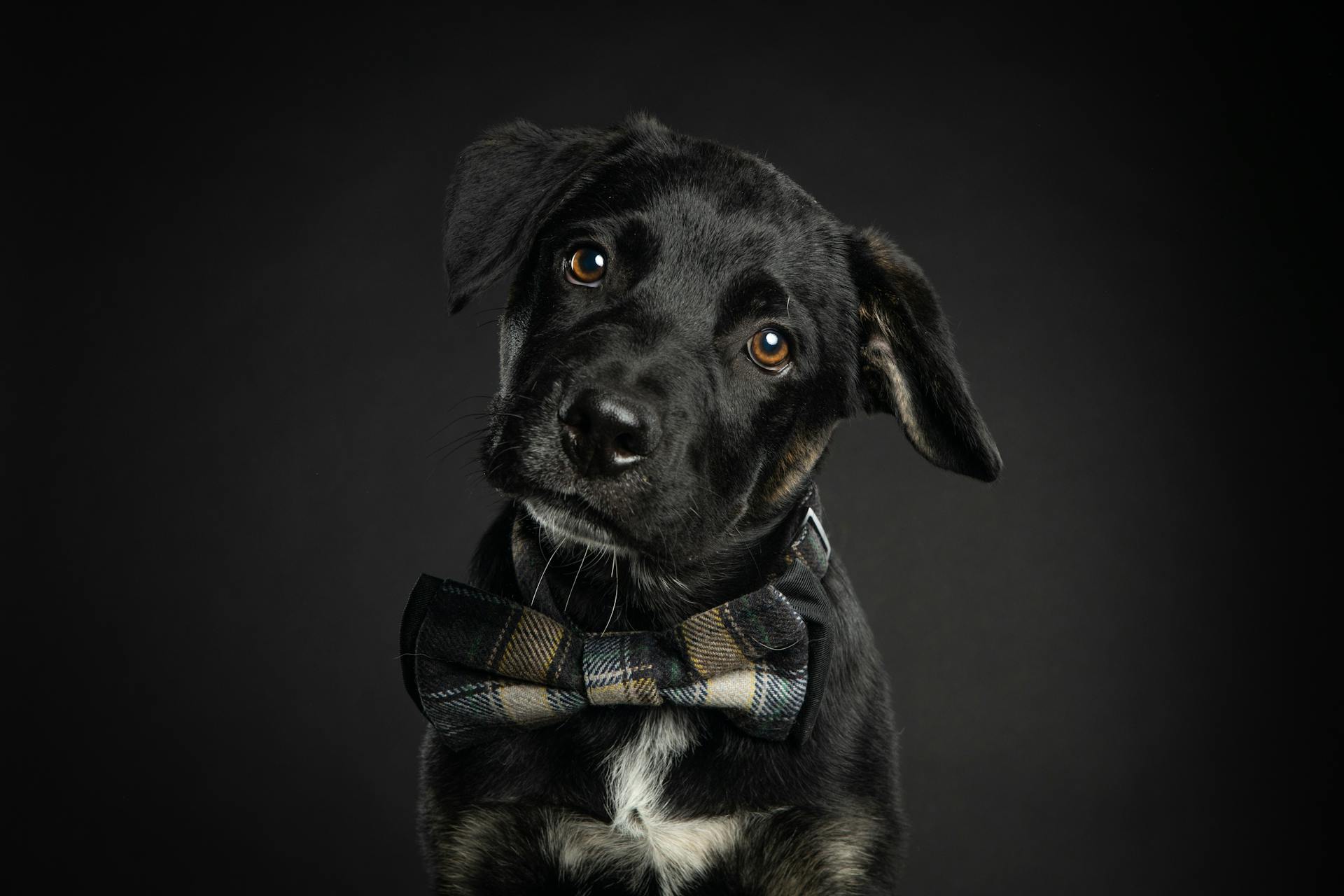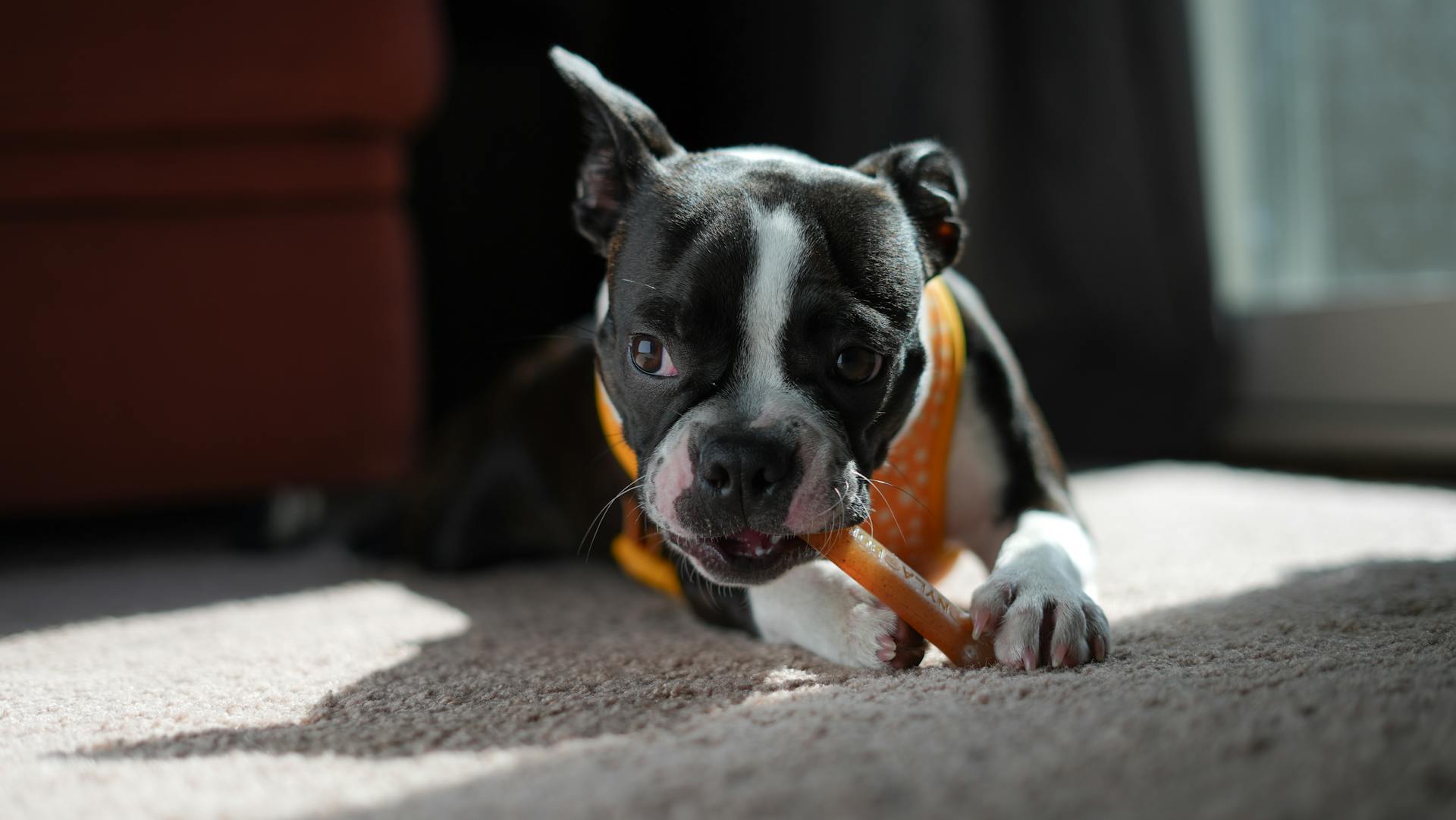
Dog dandruff and flea eggs can be a real nuisance for our furry friends.
Identifying the cause is the first step in managing the issue. Flea eggs are typically white, oval-shaped, and about 0.5 millimeters in length. They can be found on the dog's skin, particularly in areas where fleas like to lay their eggs, such as behind the ears and on the neck.
Dandruff, on the other hand, appears as small, white or yellowish flakes on the dog's skin. It can be caused by allergies, skin conditions, or even poor diet.
If you suspect flea eggs, look for live fleas or flea dirt (the dark specks that fleas leave behind) in addition to the eggs.
You might like: Miniature Schnauzer Skin Problems
Causes and Diagnosis
Dandruff in dogs can be caused by a variety of factors, including dry or oily skin, allergies, and parasites.
Dry skin can be exacerbated by low humidity levels, making it a common issue in the wintertime. Regular brushing can help keep your dog's coat lubricated with oil and prevent dryness and itchiness.
Allergies can be caused by a range of substances, including food, environmental factors like pollen or dust mites, and even materials in your dog's bedding. Common Causes of Dandruff in DogsDry or oily skinAllergiesParasitesHealth conditionsNutritional deficienciesBacterial and fungal infections
On a similar theme: Shih Tzu and Skin Allergies
Causes

Dandruff in dogs can be caused by a variety of factors, including dry or oily skin, allergies, parasites, and health conditions. Some dogs may experience dandruff due to their diet lacking essential fatty acids.
Dry skin can lead to an increase in dog dandruff production, making your dog scratch their skin frequently. Oily skin can also cause dandruff, but it's often accompanied by other symptoms like skin irritation and infections.
Allergies can cause skin irritation, leading to increased dandruff production. Food allergies, environmental allergies, and even household cleaners can be the culprits. If you notice your dog scratching their skin frequently, it may be worth investigating potential allergy triggers.
Parasites like mites or fleas can cause severe itching and irritation in your dog's skin, leading to skin damage and increased dandruff production. Regular flea preventatives can help prevent these issues.
Some health conditions, such as Cushing's disease and hypothyroidism, can also cause dandruff in dogs. Bacterial or fungal infections can negatively impact your dog's skin health, causing dandruff and other symptoms.
Here are some common causes of dandruff in dogs:
- Dry or oily skin
- Food allergies
- Environmental allergies
- Parasites (mites or fleas)
- Health conditions (Cushing's disease, hypothyroidism)
- Bacterial or fungal infections
Diagnosis of Cheyletiella Mites
Diagnosing Cheyletiella mites can be a bit tricky, but your veterinarian will likely start by taking a physical exam of your dog. They'll be looking for characteristic scaly skin along your dog's back, but not all animals show this distribution of lesions.
A flea comb is a reliable method of diagnosis, and it's probably the most accurate way to confirm the presence of Cheyletiella mites. To do this, your veterinarian will thoroughly comb your dog's body with a flea comb, collecting any scales that may be present. These scales can then be viewed under a microscope to confirm the presence of the mites.
Skin scrapings can also be used to diagnose Cheyletiella mites, but this method is less accurate than flea combing, especially in light infestations. Your veterinarian may also use acetate tape to take impressions of your dog's skin, which can then be examined under a microscope for the presence of the mites.
Here are some common methods used to diagnose Cheyletiella mites:
In some cases, your veterinarian may not be able to find the mites, but they may still suspect a parasite infestation. In these cases, they may choose to treat your dog for Cheyletiella mites and look for a response to the treatment.
Signs and Symptoms
Dandruff in dogs can be a real nuisance, and it's essential to recognize the signs and symptoms to get your furry friend the help they need.
The most common clinical finding of dog dandruff is scaling, which can be found anywhere on the body, but often appears on the back.
Itching is another common sign of dandruff, and it can be quite uncomfortable for your dog.
You may also notice hair loss and baldness in certain areas, as well as skin that appears "thick" due to secondary crusting.
Scabs, bumps, and pimples can also be a sign that your dog is suffering from dandruff.
Very few mites are necessary to cause clinical signs, so it's not always easy to spot the problem.
In fact, pets may appear normal, itching very little, but still harbor the mites.
Broaden your view: How Long Will My Dog Itch after Flea Treatment
Treatment and Prevention
Treatment for dog dandruff can vary depending on the underlying cause, but regular grooming is a crucial part of managing the condition. Brushing your dog's coat regularly can help distribute natural oils, remove dead hair and skin, and stimulate the skin to promote healthy oil production.
Bathing is also an essential part of dog dandruff treatment. However, over-bathing can dry out the skin and lead to more dandruff. A good general guideline is to bathe your dog about once a month, using lukewarm water to avoid drying out the skin.
Treatment options for dog dandruff include antibiotics for underlying infections, medicated shampoos, and topical treatments like Revolution (selamectin) or pyrethrin sprays. In severe cases, a veterinarian may prescribe a drug like Ivermectin, but this should be used with caution as it can be toxic to certain breeds.
The following treatments have been found to be effective in treating cheyletiellosis, a type of mite infestation that causes "walking dandruff":
To prevent re-infestation, it's essential to treat all animals in the household and wash all bedding, discard brushes and combs, and thoroughly vacuum carpets and upholstery.
Cheyletiellosis Treatment
Cheyletiellosis is a serious skin condition caused by tiny mites that can be contagious to other pets in the household. It's essential to treat all pets and their environment to prevent re-infestation.
The treatment options for cheyletiellosis are varied, but most involve using dips, sprays, or topical medications to kill the mites. One effective treatment is the lime sulfur dip, which should be diluted according to the label instructions and applied every 5 to 7 days for six dips.
Ivermectin is another commonly used treatment, but it's not licensed for use in certain breeds, such as Collies, Shelties, or related breeds, due to the risk of severe reactions. It's essential to consult with a veterinarian before using ivermectin.
Revolution (selamectin) is a topical treatment that can be applied every two weeks for three treatments, but it's not labeled for use in cheyletiellosis. However, it has shown promise in treating the condition.
For more insights, see: Can Dog Flea Treatment Kill Cats
To effectively treat cheyletiellosis, it's crucial to treat all animals in the household, as well as their environment, including bedding, carpeting, and furniture. This involves regular weekly treatments with dips, sprays, or topical medications, and thorough cleaning of the home to prevent re-infestation.
Here are some common treatments for cheyletiellosis, along with their application frequencies:
Remember, it's essential to consult with a veterinarian to determine the best treatment plan for your pet and to ensure all necessary precautions are taken to prevent re-infestation.
Treating Naturally
Treating dog dandruff naturally is a great option for pet owners who want to avoid harsh chemicals and promote their dog's overall health. Regular grooming is key to preventing and treating dog dandruff.
Brushing your dog's coat daily for long-haired breeds and a few times a week for short-haired breeds is crucial to distribute natural oils, remove dead hair and skin, and stimulate the skin. Brushing helps promote healthy oil production to handle dog dandruff.
Take a look at this: Walking Dandruff Dogs

Bathing your dog regularly, but not too frequently, is also important. Over-bathing can dry out the skin and lead to more dog dandruff. A good general guideline is to bathe your dog about once a month.
Trimming your dog's hair can help manage dog dandruff, especially for dogs with longer hair. Excess hair can lead to a build-up of oil and dandruff on the skin.
If your dog suffers from "dry" dandruff, look for a shampoo formulated with iodine, sulfur, or systolic acid. If your dog suffers from "oily" dandruff, find a product with benzoyl peroxide, coal tar, or selenium sulfide.
You can also try home remedies to help treat dog dandruff. Some options include: Coconut oil: Apply coconut oil to your dog's skin to help soothe and moisturize.Oatmeal baths: Oatmeal has anti-inflammatory properties that can help soothe itchy skin.Apple cider vinegar: Mix apple cider vinegar with water to create a natural shampoo that can help balance your dog's skin pH.
Remember, treating dog dandruff naturally requires patience and consistency. With regular grooming and the right natural treatments, you can help your dog feel comfortable and happy.
Here's an interesting read: Does Dog Flea Shampoo Work
Frequently Asked Questions
Is it a flea egg or dry skin?
Flea eggs are small, white, and oval, about half a millimetre long, so they can be mistaken for dry skin. Check for flea larvae, which resemble small white caterpillars, to confirm the presence of flea eggs
How do I know if my dog has flea eggs?
Flea eggs on dogs appear as tiny white specks, usually clustered together, often found on the lower back, belly, ears, and tail
What do flea eggs look like on a dog's skin?
Flea eggs are small, oval-shaped, and off-white, resembling a grain of salt. They can be easily mistaken for dry skin or sand, making them hard to spot.
Can fleas cause dandruff in dogs?
Yes, fleas can cause dandruff in dogs, as well as sores and red spots, due to excessive scratching. Regular bathing alone may not be enough to eliminate the problem if the fleas are not properly treated.
Sources
- https://www.medvet.com/cheyletiellosis-walking-dandruff-in-dogs-and-cats/
- https://www.earthbuddypet.com/eb-blog/can-dogs-get-dandruff/
- https://canna-pet.com/articles/dog-dandruff-causes-signs-treatments/
- https://www.petplace.com/article/dogs/pet-health/cheyletiellosis-in-dogs-walking-dandruff-mite
- https://www.vetdermclinic.com/causes-of-pet-dandruff-and-how-to-prevent-it-from-building-up/
Featured Images: pexels.com


